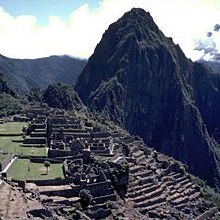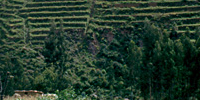explore
South America - Andean Highlands

Machu Picchu is a breathtaking ceremonial centre built c. A.D. 1500 by the Inka. In harmony with the surrounding landscape, it is a testament to their belief in the land being sacred.
The Andes mountains, the longest and second highest mountain chain in the world, form the backbone of South America.
At three different points in time, three distinctive art styles (Chavín, Wari and Inka) swept over much of the central Andes and influenced the artistic output of peoples in neighbouring geographic regions, such as the coast. In the highlands, the course of human adaptation to the landscape was uniquely reflected in the creation of cloth and clay objects.
The theme of this section is landscapes, which are the surroundings, both natural and built, that humans live within. Choose a link below to explore the highland landscape.
Machu Picchu lies at the lower end of the Urubamba valley in a spectacular setting between mountain peaks hundreds of meters above the Urubamba River in the southern Andean highlands. The architecture of the site is in harmony with the landscape, views of mountains are framed in doorways and windows, and some stones are carved into mountain shapes.
Rediscovered in 1911 by American explorer Hiram Bingham, its function is not certain, but it may have been built to honour the Inka emperor Pachakuti's conquests in the area. It was probably a site with a religious purpose. The quality of the stonework, the beautifully carved sacred monuments and sixteen spring fed fountains along with its extreme inaccessibility suggests it was a sacred place.

